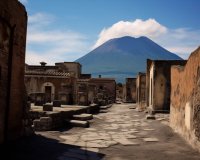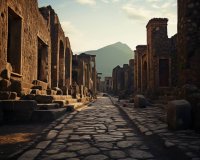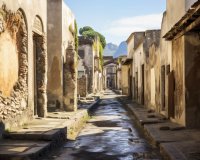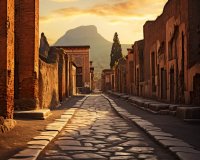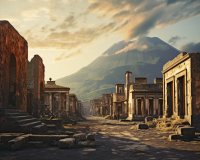A Child-Friendly Guide to Pompeii: Making History Fun

A Child-Friendly Guide to Pompeii: Making History Fun
Pompeii, an ancient Roman city near modern Naples, was buried under volcanic ash and pumice after the catastrophic eruption of Mount Vesuvius in 79 AD. Today, it stands as a remarkable archaeological site that offers a unique glimpse into the daily life of the ancient Romans. Visiting Pompeii can be an enriching and educational experience for children, as it provides a tangible connection to the past.
Exploring the Ruins
Walking through the ruins of Pompeii, children can witness the well-preserved remnants of homes, shops, and public spaces, giving them a real sense of how people lived during that time. Encourage their curiosity by pointing out the intricate mosaics, frescoes, and artifacts that have survived the test of time. Help them imagine what life might have been like for the ancient inhabitants of this city.
Learning through Interactive Activities
Several interactive activities can make the exploration of Pompeii more engaging for children. Consider participating in guided tours specifically tailored for younger audiences. These tours often involve storytelling, role-playing, and hands-on experiences, allowing children to immerse themselves in the history of Pompeii in an exciting and memorable way.
The Forum and Amphitheater
Make sure not to miss the Forum and the Amphitheater during your visit. The Forum, the heart of Pompeii's political, economic, and religious life, provides a great opportunity to discuss ancient governance and public life. The Amphitheater, where gladiatorial contests and other spectacles took place, can spark discussions about entertainment in ancient times, as well as the importance of sports and leisure activities.
Cultural Significance
Emphasize the cultural significance of Pompeii in shaping our understanding of ancient Roman society. Discuss the art, architecture, and daily customs that have influenced modern culture. Encourage children to appreciate the relevance of preserving historical sites like Pompeii, not only for their intrinsic value but also for the insights they offer into our shared human heritage.
Online Resources and Educational Materials
Before or after the visit, explore online resources and educational materials that provide additional information about Pompeii. Many websites and museums offer virtual tours, educational videos, and interactive games related to Pompeii, making it easier for children to continue learning about this ancient city long after their visit.
Preservation and Conservation Efforts
Teach children about the ongoing preservation and conservation efforts at Pompeii. Discuss the challenges of protecting historical sites from natural elements and human activity. Highlight the importance of responsible tourism and the role each individual can play in safeguarding cultural heritage for future generations.
Conclusion
Pompeii is not just a collection of ancient ruins; it is a window into a bygone era that can inspire wonder and curiosity in children. By making history come alive through engaging activities and meaningful discussions, we can ensure that the legacy of Pompeii continues to resonate with younger generations, fostering a deeper appreciation for the importance of preserving our shared history.
Private Pompei, Sorrento & Positano Full-Day Tour
Escape the hustle and bustle of Naples and embark on a journey that takes you to three of Italy's most captivating destinations: Pompeii, Sorrento, and Positano.
Highlights
Picturesque Sorrento: Be enchanted by the elegance and allure of Sorrento, a chic coastal town that beckons with its serene ambiance.
Charming Positano: Roam the labyrinthine alleys of Positano, filled with quaint shops, alfresco cafes, and exclusive fashion boutiques that capture the essence of Mediterranean style.
Ancient Pompeii: Delve into history as you tour the well-preserved remnants of Pompeii, a city frozen in time due to a volcanic eruption.
Experience the Beauty of Southern Italy
Commence your adventure from Naples, traveling along the scenic coastlines that offer mesmerizing views at every turn. In Sorrento, you have the opportunity to soak in the town's timeless charm. As you continue your journey to Positano, prepare to be spellbound by its distinctive narrow streets and vibrant atmosphere. The climax of your tour is the exploration of Pompeii's ancient ruins, providing a unique glimpse into the life of Ancient Romans.
Note: Remember to ensure your comfort during this journey by wearing appropriate footwear and bringing essentials like sunglasses and hats.
Stepping into the Ancient City of Pompeii
Pompeii, a city frozen in time, offers a mesmerizing glimpse into ancient Roman life and civilization. Located near Naples in southern Italy, Pompeii was a bustling city until the catastrophic eruption of Mount Vesuvius in 79 AD.
Walking through the ruins of Pompeii is like stepping back in time. The well-preserved remnants provide valuable insights into the daily lives, architecture, and culture of the people of ancient Rome.
History and Tragedy
The city of Pompeii was established around the 6th century BC by the Oscan people. It flourished as a trading hub due to its strategic location near the Bay of Naples. However, its fate took a dramatic turn on August 24, 79 AD, when Mount Vesuvius erupted, burying the city under layers of ash and pumice.
This devastating event led to the tragic loss of thousands of lives and the abandonment of the city. Pompeii remained buried and forgotten for nearly 1,700 years, until its rediscovery in the 18th century.
Rediscovery and Preservation
The rediscovery of Pompeii began in 1748, uncovering a remarkably well-preserved ancient city. Excavations have since continued, revealing the astonishing details of daily life during Roman times.
The city's preservation is owed to the layers of volcanic ash that enveloped it, providing a protective shield against the elements and human interference. This unique preservation allows modern-day visitors to wander through Pompeii's streets and buildings, gaining a glimpse into the past.
Architectural Marvels
The architecture of Pompeii reflects the advanced engineering and design expertise of the Romans. The city boasts well-planned streets, impressive villas, temples, theaters, and public buildings.
Notable structures include the Forum, the heart of Pompeii's political and social activities, and the Amphitheatre, a testament to the Roman love for entertainment. The House of the Vettii and Villa of the Mysteries showcase lavish Roman lifestyles and beautiful frescoes.
Everyday Life
Exploring Pompeii provides a glimpse into the daily routines of its inhabitants. The city had thriving markets, bakeries, public baths, and brothels, offering a diverse range of services to its residents.
Visitors can witness the remains of intricate mosaics, colorful paintings, and household items that provide insights into the lives of both the wealthy and ordinary citizens of Pompeii. The casts of the victims, frozen in their last moments, evoke a profound sense of the tragedy that unfolded.
Preserving the Past
Preservation efforts continue to maintain and protect the ancient ruins of Pompeii for future generations. It is essential to strike a delicate balance between allowing visitors to experience this historical marvel and ensuring the long-term preservation of the site.
Stepping into the ancient city of Pompeii is a powerful and moving experience, offering a unique window into the past. It serves as a poignant reminder of the impermanence of human achievements and the forces of nature that shape our world.
Private Guided Tour of Pompeii from Naples
Travel back to the days of the Roman Empire on a 4-hour tour of Pompeii and explore the ruins of the everyday town that was buried under molten ash by the eruption of Vesuvius in 79 AD. Discover the remains of thermal baths, brothels, villas, and restaurants frozen in time.
Explore the main sights, including the Forum, Stabian Baths, House of the Faun, and the old Amphitheater. Walk the same roads that the citizens of the Roman Republic once walked.
Upon arrival at Pompeii, choose an audio-guided tour or opt for a live guide in English, French, German, or Spanish. Enjoy approximately 2 hours at the archaeological site before heading back to Naples.
Highlights
- Explore the ruins of Pompeii with round-trip transfers from Naples
- Stroll inside the Forum, Stabian Baths, and an ancient brothel
- See the House of the Faun and the old Amphitheater
- Walk the same roads as the citizens of the Roman Republic
Discover the fascinating history of this ancient Roman town with the guidance of a knowledgeable archaeologist. Book your spot now to secure your travel plans.
The Mysteries Hidden in the Ruins of Pompeii
Pompeii, a once-vibrant ancient Roman city, was famously buried under layers of ash and pumice when Mount Vesuvius erupted in 79 AD. For centuries, it remained forgotten, a time capsule of life in the Roman Empire. The excavations of Pompeii have uncovered a wealth of information about this enigmatic city and its people, revealing a treasure trove of mysteries hidden in its ruins.
Preserved in Time
One of the most remarkable aspects of Pompeii is the level of preservation it offers. The volcanic ash that blanketed the city effectively froze it in time, providing an unparalleled glimpse into the daily life, culture, and architecture of ancient Rome. Pompeii's streets, buildings, and even its citizens' final moments have been captured for posterity.
The Unfinished Feast
Walking through Pompeii, one can't help but notice the numerous dining establishments. The city's thermopolia, or ancient fast-food joints, offer a tantalizing view of the culinary habits of Pompeiians. One can still see food counters adorned with dishes, pots, and pans, suggesting a sudden interruption in the midst of a meal, raising questions about what happened to the residents as the volcano erupted.
Frozen in Art
The art and frescoes adorning the walls of Pompeii provide unique insights into the aesthetics and values of its inhabitants. Scenes of mythology, landscapes, and daily life reveal a society that appreciated beauty, leisure, and culture. The vivid colors and intricate details of these artworks remain astonishingly vibrant even after nearly two millennia.
The Forbidden Pompeii
Beneath the city's surface, additional secrets lie hidden. The Suburban Baths, an extravagant bathhouse complex, showcase the opulence that some Pompeiians enjoyed. These baths featured erotic artwork and a mysterious underground chamber, suggesting that there may be much more to Pompeii's story than initially meets the eye.
The People of Pompeii
Pompeii's residents come to life through the cast molds of their bodies, created by the voids left by their decomposed remains. These haunting figures allow us to connect on a personal level with the city's former inhabitants. We can see their postures, clothing, and even their expressions, offering a poignant reminder of the human tragedy that unfolded in 79 AD.
The Plight of the Plaster Casts
While the plaster casts provide invaluable insights, the process of creating them has been a subject of debate. Some argue that it's a necessary evil to preserve the remains of those who perished in the eruption, while others question the ethics of exposing these individuals to such a public display. The debate continues, highlighting the complexities of studying ancient tragedies.
The Deciphering of Daily Life
From the amphitheater to the Temple of Apollo, Pompeii's ruins reveal details about the city's social structure, religious practices, and public gatherings. Archaeological findings help us piece together a comprehensive picture of daily life in ancient Rome, enabling us to understand how Pompeiians lived, worked, and entertained themselves.
The Future of Pompeii
Preservation and continued excavation are essential for uncovering more of the mysteries hidden in the ruins of Pompeii. The site remains an open book waiting for scholars to read between the lines and for curious visitors to explore. The ongoing efforts to preserve and protect this unique archaeological treasure ensure that Pompeii's secrets will continue to be revealed for generations to come.
In conclusion, Pompeii's ruins are a window to the past, offering a captivating look at the lives and culture of ancient Romans. The mysteries buried beneath the layers of ash continue to be unveiled, shedding light on a city that was frozen in time by a catastrophic event.



